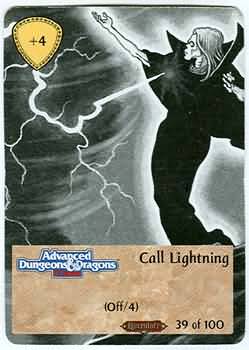Call Lightning
(Alteration)

Call Lightning
(Alteration)

|
|
|
|
|
|
|
|
|
|
|
|
|
|
|
 |
|
|
Effect: When a call
lightning spell is cast, there must be a storm of some sort in the
area
-- a rain shower, clouds
and wind, hot and cloudy conditions, or even a tornado.
The druid
is then able to {call} down bolts of lightning
from sky to ground.
Each bolt will cause damage
equal to 2 eight-sided dice (2d8) plus 1 like die (d8) for each level of
experience of the druid casting the spell.
Thus, a 4th level druid
calls down a six-die (6d8) bolt.
The bolt of lightning flashes
down in a perpendicular stroke at whatever distance the spell caster decides,
up to the 36" radial distance
maximum.
Any creature within a 1"
radius of the path or the point where the lightning strikes will take full
damage,
unless a saving throw is
made, in which case only one-half damage is taken.
Full/half damage refers
to the number of hit dice of the lightning bolt,
i.e. if it is of eight dice
strength, the victim will take either eight dice (8d8) or four dice (4d8),
if the saving throw is made, of damage. The druid is able to call one bolt
of lightning every 10 melee rounds (1 turn),
to a maximum number of turns
equal to the level of experience he or she has attained, i.e. 1 bolt/turn
for each level of experience. Note: This spell is normally usable outdoors
only.
DMG: If a djinn or
an air elemental is on hand to form a whirlwind,
the druid is able to summon
half-strength lightning strokes therefrom.
Call Lighting: An important point only
mentioned in the DMG is that half-strength
bolts can be created even if
weather conditions are not ideal -- and
even underground -- if a (presumably
friendly, or at least non-hostile) djinn or
air elemental is within the spell
range.
(Imagine #30)
WSG: The magical lightning
brought into existence by
this spell is generally
less lethal than natural lightning - but the
chance of a character being
hit by natural lightning is usually
quite small, whereas a bolt
of magical lightning will always hit a
target within range of the
area where it strikes, and will always do
at least half damage. To
an outside observer, magical lightning is
indistinguishable from natural
lightning in appearance; thus, a
character or creature who
witnesses it or is struck by it will not automatically
know that the lightning
was caused by an external
force - but if more than
one strike hits a target or targets within a
relatively short time, witnesses
may logically suspect that nature
is not entirely to blame.
Natural lightning can also occur during
the duration of this spell,
as long as conditions permit (ie., a
storm must be actually occurring
and not simply about to happen,
as might be the case under
“hot and cloudy conditions”).
Q: Can call lightning
be used against
submerged creatures?
A: The bolt from
a call lightning spell ends
at the water?s surface,
but its 1? radius of
effect extends below the
surface and has
its full effect on any submerged
creature
therein.
(153.7)

garhkal wrote:
Here is one that came up
ONCE in a game.
I was wondering if i handled
it right..
Cleric (or druid) casts call
lightning.
Completes his turn, and
casts a second, while waiting to use his additional bolts from the first,
delaying the additional 'bolt' until completion of the spell.
Uses both bolts, then casts
a third one, while waiting, and delays them too...

That's a tough question.
I am not so sure that a druid could delay the gathering of the electrical energy to make the ligntning bolt...
I'd have a check based on
his level, with a roll equal to it or less meaning the attempt was a success,
otherwise, it would fail, and the bolt would hit--
more or less willy-nilly
if the check roll exceeded 17.
FWIW,
Gary